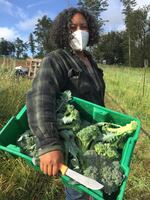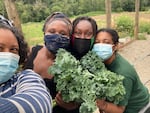Not everyone would choose a career that involves endless days of hard, physical work, virtually no vacation and dismisses the possibility of ever retiring. But in 2015, that’s just what Shantae Johnson and Arthur Shavers did when they decided to become farmers.
The two Portlanders both have farming in their background. Johnson’s great-grandmother raised chickens and sold berries and vegetables from a seven-acre farm in Oregon City.
Shavers’ grandparents moved from their farm in Texas to Portland, where his grandfather found work in the World War II shipbuilding boom, while his grandmother grew food for their 11 children as well as the local community.
Moved by the dream that they could revive their families’ farming roots and raise their kids in a more rural setting, the couple quit their jobs and enrolled in Oregon State University’s Beginning Urban Farming Apprenticeship Program to learn market farming.
Shavers remembers their apprenticeship classmates’ reaction to the plan.
“They were like, ‘So you’re telling me you don’t have any land. You both quit your jobs. You have six kids between the two of you and you think you’re going to be a farmer in the city? …Full time?’” Shavers laughs at the memory. “And I was like, ‘Yeah, that’s exactly what we think.’”
Their absolute faith was rewarded when just as soon as they finished the program, the Oregon Food Bank agreed to lend them a small plot of land in North Portland to start their own farm business.

Shantae Johnson of Mudbone Grown with a harvest of fresh broccoli
Jule Gilfillan
They called their enterprise Mudbone Grown (after Shavers’ nickname “Mudbone”) and began digging up the grants and partnerships to grow it. Their first season’s harvest supplied 20 local families with fresh produce for 13 weeks. Then in partnership with the Oregon Food Bank, they launched a stipend-supported program to train young farmers of color. From the beginning, their goal was much higher than just growing food.
“It’s a lofty goal,” Johnson admits. “But we really want to reimagine what it looks like to be a Black farmer here in Oregon, specifically.”
That goal means addressing many of the barriers that Black farmers have encountered here since before Oregon even became a state.
While attending a farming conference a few years ago, Shavers began perusing the various display tables and noticed that many families owned farms of more than 2,000 acres. The wheels in Shavers’ mind began to turn.
“I literally pulled my phone out and just started Googling the families’ names and their farms. And it occurred to me, we’re sitting in this room with all these people, we’re working on an acre and a half of borrowed land from the Oregon Food Bank and these families are in here with thousands of acres. And I just started wondering, how did they get that much?”
Oregon’s racist history
A good part of the answer can be traced back to the nineteenth century.
The Oregon Donation Land Act of 1850 codified the rights of “white male citizens and their wives” to claims of 640 acres of “public” land granted to them by the future state’s provisional government in 1843. Blacks were excluded by virtue of being neither “white” nor “citizens.”
“To get free land you had to be a citizen,” explains Darrell Millner, Professor Emeritus and former Black Studies Department Chair at Portland State University. Milliner characterizes the barriers to Black land ownership as “complicated.”
“According to the U.S. Supreme Court Dred Scott decision of 1857, Blacks could not be a citizen and furthermore had no rights and no access to the courts,” he says.
Though Oregon elected not to become a slave state, its constitution excluded Blacks from settling here (Article XVIII, Section 4):
No free negro or mulatto, not residing in this State at the time of the adoption of this constitution, shall ever come, reside or be within this State.
“When the original Oregon constitution was adopted in 1857 and statehood granted in 1859, Blacks were specifically prohibited from owning any real estate in Oregon,” says Millner.
“Those laws, while important, are not the MAIN reason more Blacks did not come (here). The main reason is that most Blacks at the time were enslaved!” Millner wrote in an email. “Slaves don’t get to make that kind of decision as to where they might want to live.
“What the exclusion laws did do very effectively was DETER the few blacks who might have come to Oregon from making that decision in the first place knowing what those laws revealed about the racial environment they would find in Oregon should they get here.”
The state’s Black exclusion policy was repealed in 1926, but the impact of both the laws and racist sentiments still show up in Oregon today.
Less than one tenth of one percent
Compiled from U.S. Department of Agriculture and Oregon Census of Agriculture data, a 2017 OSU Extension fact sheet revealed that 96.7% of Oregon’s farm producers were white. The numbers showed that of the state’s 67,595 farm producers, only 64 were Black.
For Shavers and Johnson, the connection between Oregon’s racist history and the 21st-century land ownership patterns they saw at the farm conference was “eye-opening.”
“When you look at land, that’s how people build generational wealth,” Johnson explains. “So, when some of the white farmers can say that ‘I’m fifth-generation farmer, I’m a sixth-generation farmer,’ that farm was passed down from family member to family member. And here in Oregon, you don’t nearly hear that at all for Black farmers. And so even though our families have farming experience, they did not have access to big plots of land like that and it was not passed down to us. And that’s the reality for many young beginning Black farmers here.”
To address that reality, Shavers would like to see a system put in place to ensure Oregon’s agricultural lands are not sold to industrial or out-of-state interests, but instead put into the hands of the state’s Black and other small-scale farmers.
“We need things that we can consume and feed ourselves with. So, there’s got to be some effort around that, and I believe it’s happening right now.”

Shantae Johnson (left) snaps a selfie with the farm crew at Mudbone Grown's Feed 'Em Freedom Farm
Shantae Johnson
Johnson agrees: “I do believe that there is a great opportunity to change that narrative starting now. But we do need to get behind helping Black farmers gain access to land and the infrastructure they need to establish their farms in order to change that narrative.”
To those ends, Shavers and Johnson are working with the Black Oregon Land Trust and the Black Food Fund. Among BOLT’s aims is the creation of cultural easements where Black farmers can access land to grow food, build community and practice culture. The Black Food Fund is engaged in bringing capital to Black participation in Pacific Northwest food systems. In practical terms, that means fostering investment in infrastructure projects like building greenhouses, cold storage and commercial kitchens, as well as the labor to accomplish these projects.
Reconnection through the land
In 2018, the couple secured a long-term lease on a 19-acre property near Corbett. Since then, they’ve built an access road, a greenhouse, installed irrigation, laid the foundation for aquaponic production and put about eight acres under food cultivation. They also partnered with the local Veterans Administration to host a “Boots 2 Roots” program to teach vets how to build their own farm businesses and started the “Pathways to Farming” program to train young farmers of color.
By 2020, the Mudbone Grown farming operation had overcome many of the bureaucratic barriers rooted in systemic racism. But Johnson and Shavers also recognized the need to confront the psychic wounds to which many African Americans are heir from generations of enslavement.
“There’s a lot of historical trauma that people have around farming, and there’s a lot of people pushing away from that. A lot of younger people that are like, Well, I don’t want to be out in the field. I don’t want to do that type of work. But it is honorable work,” Johnson explains. “And in reconnecting community to farming and growing food, it’s like you’re helping to activate a seed in a way and kind of waking that up within people.”

Arthur Shavers of Mudbone Grown
Courtesy of Mudbone Grown
For Shavers, these past five years living close to the land are proof of it.
“There’s a weird thing that happens to me like, I could go through a day, have all kind of challenges, struggles, you know, my body aches. …But what I find incredible is that when I wake up the next day, sometimes I have to try really hard to remember what were the things that really would bother me the day before? Because I wake up every day refreshed, ready to start again. And I don’t know if that’s just because I’m enjoying this life or if this land actually does something to help. But I feel like there is something healing about sleeping under the stars, listening to these crickets and coming out and playing on this earth, micro-organisms all over me every day. I feel like it is doing something internally, and it makes me better.”
“We really love what we do. And we are going to farm probably till the day that we die.” Johnson gets emotional as she talks about her and Shavers’ love for the land, for building community and the many partnerships that have helped them realize their dream.
“We want to be an example to other people that it can be accomplished and it can be done. That’s where the reimagining happens.”
